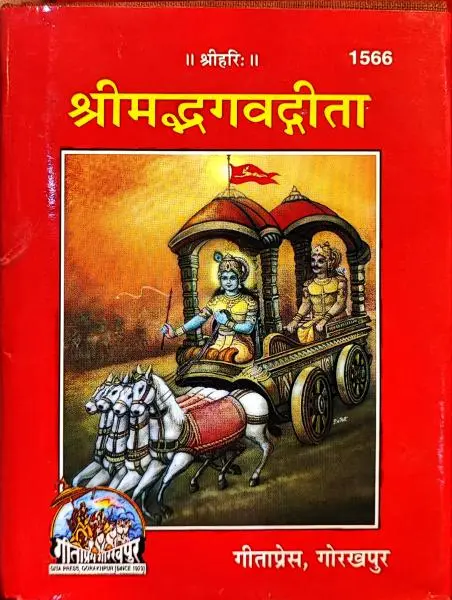Understanding Gita Made Easy | Simplified Bhagavad Gita Explanation by D. N. Verma
By Prof. Pradeep Mathur
The Bhagavad Gita, described by Mahatma Gandhi as the root of all spiritual wisdom, is not only a treasure trove of timeless philosophy but also a deeply embedded part of Indian cultural folklore. At its heart lies a powerful narrative — a divine guide, Lord Krishna, agrees to serve as the charioteer of a brave yet morally conflicted prince, Arjuna. This simple, dramatic setup unfolds into one of the most profound dialogues on duty, righteousness, and the path to spiritual realization.
In many educated Hindu households, children are introduced to the Gita through cultural practices: celebrations like Krishna Janmashtami, visits to temples in Mathura and Vrindavan, and, of course, the stories of the Mahabharata, which are often heard in fragments rather than in a coherent manner. This fragmented exposure, though incomplete, leaves a deep and lasting impression. It shapes the way we think and act, sometimes in ways we don’t even consciously realize.
I recall my own first encounter with the Gita. I was in higher secondary school when my father handed me a small book by C. Rajagopalachari — an English translation of the Gita. At that time, in the 1960s and 70s, our exposure to spiritual texts was limited compared to the multimedia access children enjoy today. As a Hindi-speaking boy from North India, I was initially surprised — even confused — to see a South Indian author writing in English about the Gita. It seemed odd, even misplaced, to my young and inexperienced mind.
Yet, as I began to read it, I realized the book wasn’t difficult to understand, though the deeper meanings eluded me for some time. Like many others, my knowledge of the Gita was patchy and anecdotal. I drew my own interpretations from isolated stories and verses. One impression that stood out strongly for me was of Arjuna’s unwavering determination. Despite his internal conflict, he vowed not to surrender or flee the battlefield.
As a teenage boy, I faced two personal struggles: I was a poor batsman in our neighborhood cricket club, scared of the red cork ball, and I yearned to excel in academics to match the achievements of my seniors. Motivated by Arjuna’s resolve, I began writing on the covers of my exercise books: “Arjuna se pratigya dwaya – na daaniyam, na palayanam” (Arjuna made two vows — not to surrender, and not to retreat from battle). Whether it actually helped improve my grades or my cricketing skills is debatable, but my classmates were certainly impressed!
The Gita is just one episode within the vast and mesmerizing epic that is the Mahabharata. But absorbing the Mahabharata in bits and pieces can be misleading, even dangerous. Without context, one might be left with impressions of blind ambition, betrayal, fratricide, and unchecked greed — themes that certainly exist in the narrative. There’s the tale of a blind king unable to curb his sons’ ambitions, cousins killing one another and even their own children, revered elders siding with evil to protect their positions, gambling that stakes kingdoms and princesses, and the harrowing episode where a woman is publicly disrobed while powerful men watch in silence.
While Lord Krishna’s discourse in the Gita provides light and clarity, these darker episodes can cloud the minds of those who lack the maturity or guidance to interpret them properly. This is why it is essential that the Mahabharata — and especially the Gita — be presented in a straightforward and accessible way, where the triumph of virtue over vice, and clarity over confusion, is clearly conveyed.
In this context, I am glad that Mr. D. N. Verma has taken up the important task of simplifying and contextualizing the Bhagavad Gita. His book, Understanding Gita Made Easy, is a timely and welcome effort. It addresses a long-standing need for a text that distills the essence of the Gita in a relatable and accessible form — particularly as a tool for personality development grounded in Indian philosophy and culture.
Mr. Verma’s background is unique. A lawyer by training who transitioned into a career as a bureaucrat in the Ministry of Information and Broadcasting, he spent over three decades immersed in officialdom — scanning files, drafting notes, and navigating government corridors. Yet, remarkably, he kept his creative instincts alive. Now in his mid-eighties, he writes with the curiosity, clarity, and enthusiasm of a much younger man.
What makes this book special is that it’s not written by a high priest of theology or a professional philosopher. Mr. Verma does not claim to be a great scholar of the scriptures, nor a spiritual guru. And that, perhaps, is his greatest strength. This is a book by a common man, for the common reader. It simplifies rather than mystifies. It demystifies rather than preaches.
By retelling the Gita in a simple, storytelling format, Mr. Verma makes the teachings of Lord Krishna accessible to everyone — young and old, believer and seeker. Each chapter explains the context of the Gita’s verses, followed by a summary of Krishna’s teachings that distills complex spiritual philosophy into life lessons that can be applied to everyday situations — be it in your home, workplace, or personal relationships.
The real strength of the book lies in its narrative style — engaging, clear, and uncluttered. Unlike many moral or philosophical texts that come across as dry or overly dense, this book is fluid and interesting. It raises questions that naturally arise in a thoughtful mind and offers answers that encourage introspection rather than blind belief.
Spanning about 33,000 words, Understanding Gita Made Easy is compact and pocket-friendly, both in size and spirit. It is the kind of book you can carry with you, turn to in times of stress, and use as a guide to navigate life’s dilemmas with balance and wisdom. In our modern world, filled with anxiety, conflict, and confusion, such a resource is not just helpful — it’s essential.
One hopes that the book will soon be made available in Hindi and other Indian languages to ensure wider reach and accessibility. The core messages of the Gita — self-awareness, righteousness, detachment, and clarity in action — are universal and timeless. They deserve to be heard by all, not just those fluent in English.
In conclusion, Mr. Verma has given us more than just a book. He has given readers a companion — one that speaks in a familiar voice, offering guidance without judgement, and encouraging us to seek clarity within ourselves. His effort reaffirms that the Gita is not a text for the old or the religious alone; it is a living guide for anyone seeking purpose, peace, and integrity in the chaos of modern life.
Let us hope this effort reaches as many hands and hearts as possible.





